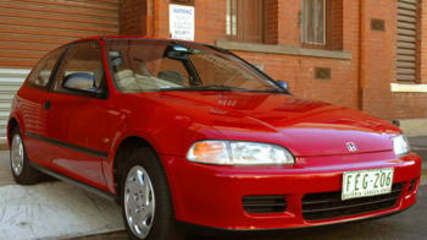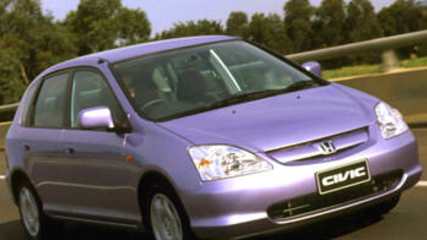Used Honda Civic review: 1991-1995
By Graham Smith · 28 Jan 2009
The Civic quickly won a following after it was launched here in the early 1970s. It was stylish, economical, performed well, and was well built, the same qualities that drive Civic sales today.The Civic was never a cheap small car; those perceived qualities so loved by Australians came at a price. So much so that the Civic lost ground to its rivals as other carmakers, Mazda, Subaru, Nissan, and Toyota closed the gap through the 1980s and early 1990s.In that crowded small car arena there wasn’t as much that made the Civic stand out as it had in past times. It was still stylish and well built, but its performance was lacklustre and it was no longer as economical when those were key qualities small car buyers wanted.Perhaps the thing that brought the Civic out of the doldrums it found itself in was the arrival of the VTEC engine. With its clever variable valve timing and lift system Honda could extract quite amazing performance from a small engine. With the VTEC engine under its bonnet the Civic, particularly the performance-oriented VTi, came to life.In the blink of an eye the well-built small car was transformed. There was good reason to buy the Civic again.MODEL WATCHThe heavily revised fifth generation Civic Honda launched late in 1991 wasn’t anything to write home about. It was a little larger than its predecessor, its styling was wishy-washy without being in any way offensive, its performance was breathless, but it handled well, and was well built.The new Civic range opened with the Breeze, a bright and bubbly three-door hatch with a 1.3-litre single overhead camshaft, carburettor fed four-cylinder engine that managed to produce 55 kW at 6300 revs. It had a five-speed manual gearbox and power steering was standard. The performance wasn’t great, but the economy was acceptable.The mid-range GL came in four-door sedan and three-door hatch forms. It had a 1.5-litre single overhead cam four cylinder engine with twin carburettors, which produced 74 kW at 6300 rpm.There was a choice of five-speed manual or four-speed automatic gearboxes, and the list of standard equipment included power windows and mirrors, central locking, tachometer and an Alpine radio cassette system.This was a disappointing performer, and thirsty to boot.Top of the range at launch was the Si, which also came as a four-door sedan or three-door hatch. Power was from a 1.6-litre double overhead camshaft fuel-injected four-cylinder engine that boasted 96 kW.It too had a choice of manual or auto transmissions, along with four-wheel disc brakes, upgraded trim, and tilt adjustable steering wheel.The VTEC variable valve-timing engine made its first appearance in the four-door VEi sedan, which was released in 1993. It was a 1.5-litre single overhead cam engine configured for fuel economy. It produced 66 kW, and was offered with a five-speed manual trans only.Other standard features included a driver’s airbag, power steering, central locking, power windows and mirrors, tachometer, and cloth trim.As long as you weren’t expecting much get up and go the VEi was worth a look.In September 1993 the Civic came in for a much-needed mid-life makeover, with a raft of revisions, particularly to the engines offered.The Breeze got a new lease on life with a 1.5-litre single overhead camshaft four-cylinder engine, which now had throttle body injection, and produced 67 kW.The GLi replaced the GL with a 1.5-litre multipoint fuel-injected single overhead cam four-cylinder engine that developed 74 kW.Fuel economy continued to be the main focus of the VEi with its 1.5-litre VTEC/E engine, which produced peak power of 66 kW.If economy was a priority for the VEi, the new VTi was a breath of fresh air with the emphasis on performance. Available as a sedan or hatch it was a taste of what was to come as Honda developed it system of variable valve timing and lift.The VTi had a 1.6-litre double overhead camshaft four cylinder engine with 96 kW on tap at 6600 revs. It had plenty of low down grunt as well as impressive top end zip, endowing the VTi Civic with impressive performance.Standard equipment on the VTi included four-wheel discs, electric sunroof, cloth trim, and four-speaker AM/FM cassette sound.Driver’s side airbags became standard across the Civic range in August 1994.IN THE SHOPGenerally the trade highly rates the Civics after the revised engines arrived late in 1992. Prior to that, they say, the engines were generally thirsty and lacked performance.The VTi is highly regarded and easily the pick of the bunch. It’s got good performance while still delivering impressive fuel consumption.Performance and economy issues apart, Honda engines, as well as gearboxes, drive lines and diffs are robust and give little trouble. Rear wheel bearings are a source of trouble.The problems are mostly related to ancillaries, like air-conditioning compressors, which are a known source of trouble.There are no real problems with the Civic body, they’re well built in the first instance and stand up well in service. Same goes for the paint, which continues to shine if maintained as it should be.Check for service record, and evidence of regular maintenance.OWNERS’ VIEWSKristen Jones has owned her 1993 Honda Civic Breeze for four years, and says it has been very cheap to run, and easy to drive and park. She has had no problems with it and would happily recommend it.Debbie Williamson bought her 1993 Civic GL new, and has now done 210,000 km. She says it is reliable, comfortable, economical, attractive, and roomy, is easy to drive and to this point has had nothing go wrong.Jim Liaskos has owned his 1994 Honda Civic manual GLi for 10 years. It has now done 240,000 km, and he says it handles well and is very economical. Apart from normal service items, he has replaced the front wheel bearings, the clutch master cylinder, noisy gearbox bearings, thermostat, and the brake master cylinder.LOOK FOR• good build quality• robust and reliable mechanicals• poor performance and fuel economy prior to 1991 engine upgrade• noisy rear wheel bearingsTHE BOTTOM LINEThe Civic was struggling to live up to its reputation before the revised engine range arrived in late 1991, and improved both its performance and economy.RATINGPre-1993 – 60/100; Post-1993 – 75/100








